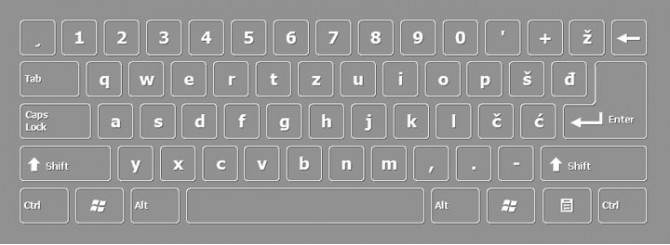CROATIAN DESKTOP KEYBOARD FREE DOWNLOAD
The QWERTZ or QWERTZU keyboard is a widely used computer and typewriter keyboard layout that is mostly used in Central Europe. The name comes from the first six letters at the top left of the keyboard: Q, W, E, R, T, and Z.
The main difference between QWERTZ and QWERTY is that the positions of the Z and Y keys are switched (hence the jocular nickname of "kezboard"). This change was made for two major reasons:
"Z" is a much more common letter than "Y" in German; the latter rarely appears outside words whose spellings reflect either their importation from a foreign language or the Hellenization of an older German form under the influence of Ludwig I of Bavaria.
"T" and "Z" often appear next to each other in the German orthography, and placing the two keys so they can be typed with different hands index finger minimized typewriter jams.
Like in many other non-English keyboards:
Part of the keyboard is adapted to include language-specific characters, e.g. umlauted vowels (ä, ö, ü) in German and Austrian keyboards.
QWERTZ keyboards usually change the right Alt key into an Alt Gr key to access a third level of key assignments. This is necessary because the language-specific characters leave no room to have all the special symbols of ASCII, needed by programmers among others, available on the first or second (shifted) levels without unduly increasing the size of the keyboard.
The placements of some special symbols are changed when compared to the English (UK and US) versions of QWERTY.
Some of special key inscriptions are often changed from an abbreviation to a graphical symbol (for example caps lock becomes a hollow arrow pointing down, backspace becomes a left-pointing arrow). In German and Austrian keyboards, most of the other abbreviated labels in German: "Ctrl" (control) is translated to its German equivalent "Strg" for Steuerung, and "Delete" is abbreviated "Entf" (entfernen). "Esc" and "Enter" on the numeric keypad are not translated, however. (See: German keyboard layout#Key labels)
South Slavic Latin
Bosnian, Croatian, Serbian and Slovene keyboard layout
The Bosnian, Croatian, Serbian Latin and Slovene keyboard layout has five additional special characters Č, Ć, Ž, Š and Đ. This keyboard layout was standardized in the 1980s in Yugoslavia. Characters Ć and Đ are only part of Gaj's Latin alphabet but not part of the Slovene alphabet, nevertheless they remain in Slovenian keyboards (for economic reasons, for historical reasons and for writing words in the closely related South Slavic languages). The Ž is on the right side of the Ć key on keyboards which have a longer backspace key, and the usual inverted L shaped Enter key. The layout makes heavy use of the AltGr (right Alt) key for non-alphabetic characters and dead key combinations for adding diacritics to Latin characters. It is possible to type German and Italian using only the Bosnian/Croatian/Serbian keyboard layout.
There is a proposed variant of new Slovene keyboard layout, which would remove Ć and Đ from top layout and add @ instead. The command keys would also become translated into Slovene and some minor second level layout changes would be made.
Frontype is easy to use multilingual user-friendly virtual onscreen keyboard that turns any keyboard to your language layout. Just add needed language as input and start to type!
Write a review about CROATIAN DESKTOP KEYBOARD FREE DOWNLOAD
Your Name:Your Review: Note: HTML is not translated!
Rating: Bad Good
Enter the code in the box below:






















